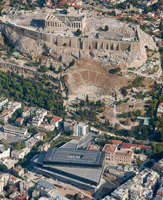 |
 |
 |
 |
 |
 |
| |
 |
|
 |
 |
 |
  |
  |
 |
 |
 |
 |
| The new Acropolis Museum in Athens
|
|
June 19, 2009
 The historic masterpieces of the New Acropolis Museum - including the archaeological remains of ancient Athens left visible beneath the building and portions of the glorious Parthenon Frieze installed at the top - will be displayed in total for the first time when the Museum celebrates its much-anticipated official opening on Saturday, June 20, 2009. The historic masterpieces of the New Acropolis Museum - including the archaeological remains of ancient Athens left visible beneath the building and portions of the glorious Parthenon Frieze installed at the top - will be displayed in total for the first time when the Museum celebrates its much-anticipated official opening on Saturday, June 20, 2009.
Designed by Bernard Tschumi Architects of New York/Paris with Michael Photiadis of Athens as local associate architect, the Museum has presented a number of temporary exhibitions in a lower-floor gallery over the pastyear. With the official opening, visitors will at last view the full suite of galleries, presented in a dramatic architectural experience designed explicitly for this collection. With more than 150,000 square feet (14,000 sq.m.) of exhibition space - ten times more than the previous Acropolis museum - the New Acropolis Museum will display surviving antiquities from the Acropolis and serve as a catalyst for strengthening international interest in the classical world. The 226,000 square feet (21,000 sq.m.) Museum is both a defining cultural project for Greece and a key reference point for the art community around the globe. To present the unparalleled collection, architect and lead designer Bernard Tschumi created a deliberately non-monumental structure whose simple and precise design invokes the mathematical and conceptual clarity of ancient Greek architecture. “The form of the building arose as a response to the challenges of creating a structure that was worthy of housing the most dramatic sculptures of Greek antiquity, and doing so in an over whelmingly historic and monumental setting,” explains Tschumi. “The site at the foot of the Acropolis confronted us with the Parthenon itself, one of the most influential buildings in Western civilization. At the same time, we had to consider the sensitive archaeological excavations, the presence of the contemporary city and its street grid, and the special challenges of the hot climate in Athens and an earthquake region.”
» Read more |
|
 |
  |
 |
|
|